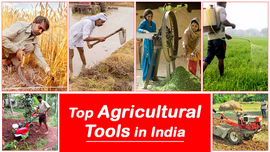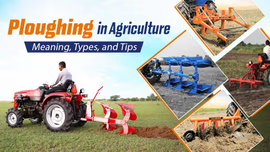Know Everything About Cultivator: Its Types, Uses and How to Attach It

A cultivator is one of the most used secondary tillage implements in India. In some parts of India, it is used as a primary tillage to till the land. In this blog, we have detailed the types and uses of cultivators and how we attach them to get better performance to prepare uniform seedbed.
Table of Content
- Introduction
- What is a Cultivator?
- What are the Uses of a Cultivator?
- What are the Types of Cultivators?
- What are the Different Parts of a Cultivator?
- What Adjustments are Required Before Attaching a Cultivator?
- How to Attach a Cultivator to a Tractor?
- What Safety Measures Shall We Take While Attaching a Cultivator?
- Conclusion
Introduction
Sowing is the first step in crop cultivation. Effective sowing requires a levelled and prepared seedbed, which is made ready by turning and loosening the soil with the help of tillage implements. And one of the most used tillage implements is a cultivator.
The cultivator is the most used implement after the rotavator in India. It is a secondary tillage implement that is an intermediate between ploughing and harrowing. Sometimes, it is also used as primary tillage to plough the field. However, the main function of a cultivator is to destroy the weeds and pierce the soil deep to break the large clods. A cultivator uses its tynes or discs for this purpose.
A cultivator for the first time was used in North America during 1915 – 1920 when the Fordson-designed cultivator became a phenomenon on large-scale farms.
What is a Cultivator?
In agriculture, cultivator is tractor-operated implement to prepare the seedbed with the help of laterally aligned adjustable tynes or discs, which are designed to work between row of crops. The tynes can also be vertically adjusted.
What are the Uses of a Cultivator?
- Tills & turn over the soil and break the soil clod.
- Prepares the seedbed before sowing.
- Aerates the soil for proper growth of crops.
- Uproot the weeds in the field.
- For sowing when attached with a sowing attachment.
What are the Types of a Cultivator?
Depending on the type of teeth used to till the soil, a cultivator can be classified as:
- Tyne Cultivator – It is fitted with tynes having shovels.
- Disc Cultivator: It is fitted with discs.
Further, these cultivators are classified as a trailed type or a mounted type. A mounted type is again classified into a rigid tyne cultivator and a spring tyne cultivator. Let us see each one in brief.
Trailed Type Cultivator
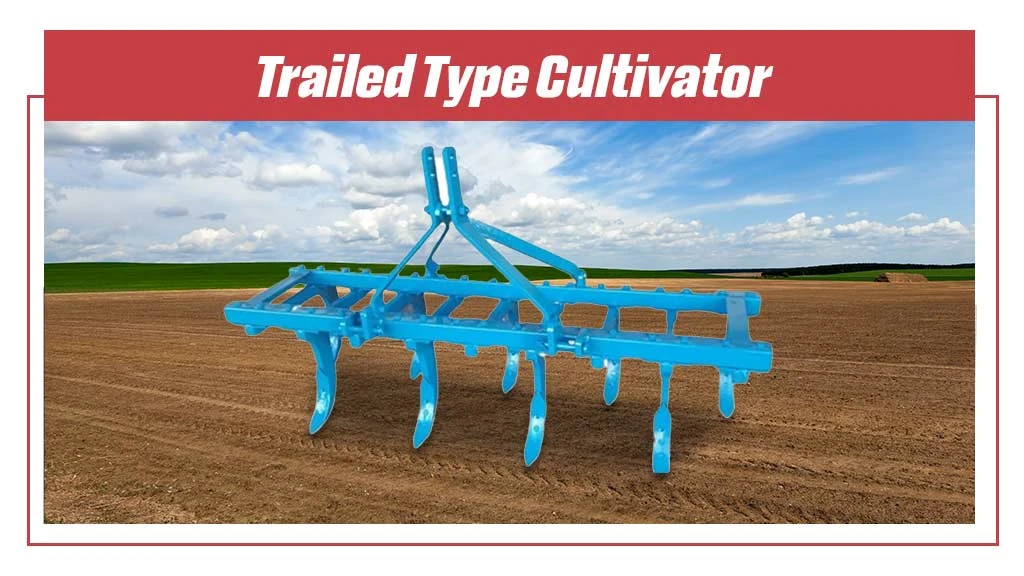
These types of cultivators require the drawbar power of the tractor. They consist of a main frame with cross members, widely spaced tynes and a pair of wheels. These cultivators are attached to the tractor with the help of a hitch arrangement given at the front.
In these cultivators, tynes are adjusted in their clamps to set the depth of working and the screw lever control the final depth. The wheels help maintain the draft.
However, the tynes of these cultivators are prone to damage as they are turned at the headland without being lifted.
Mounted Type Cultivator
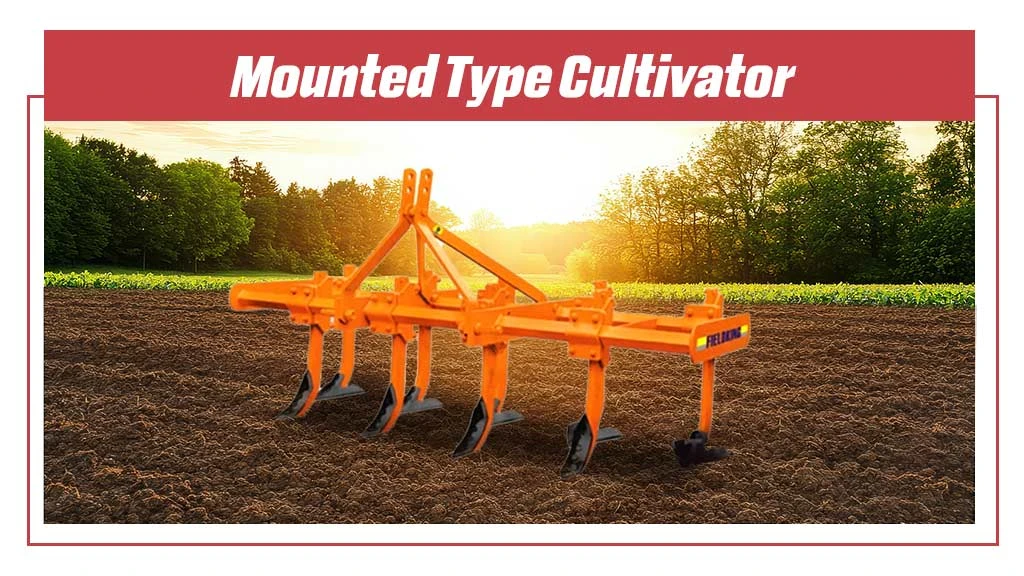
These cultivators are operated hydraulically. Thus, they are mounted on tractors with hydraulic systems. These cultivators consist of a main frame with cross members, tynes in two staggered lines, three-point hitch, shovels and sweeps.
Depending on the type of crops and soil, different shovels are used in these cultivators. Some of the shovels are single-point shovels and double-point shovels.
Rigid Tyne Cultivator
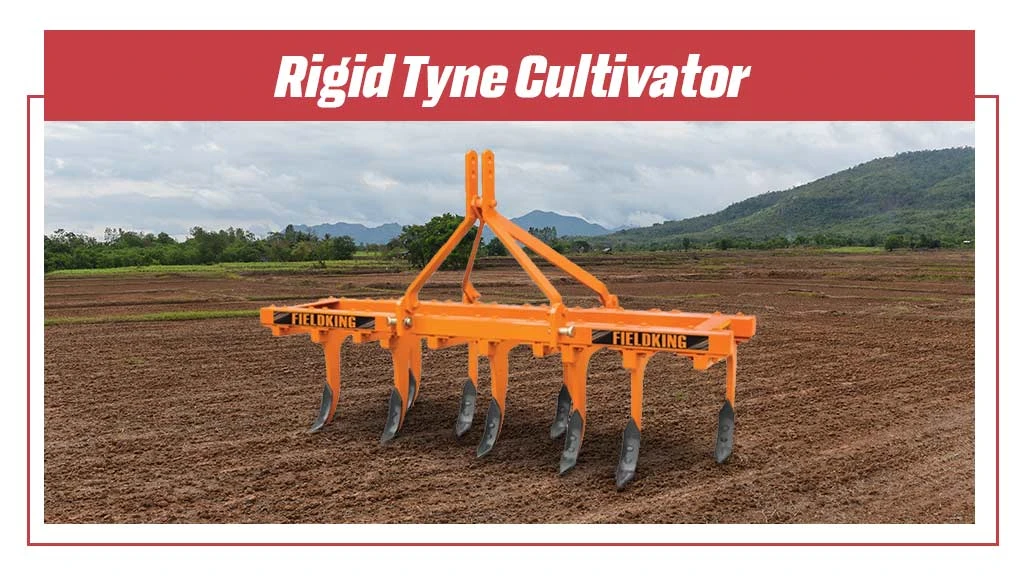
These cultivators have rigid tynes that do not deflect during work in the field. In these types, the tynes are bolted between angle braces and are fastened to the main frame with the help of sturdy clamps & bolts.
The easily adjustable tynes spacing in these cultivators ensures that tynes are not choked with stubbles. In these cultivators, the depth of working is controlled with the help of a pair of gauge wheels.
Spring Loaded Tyne Cultivator
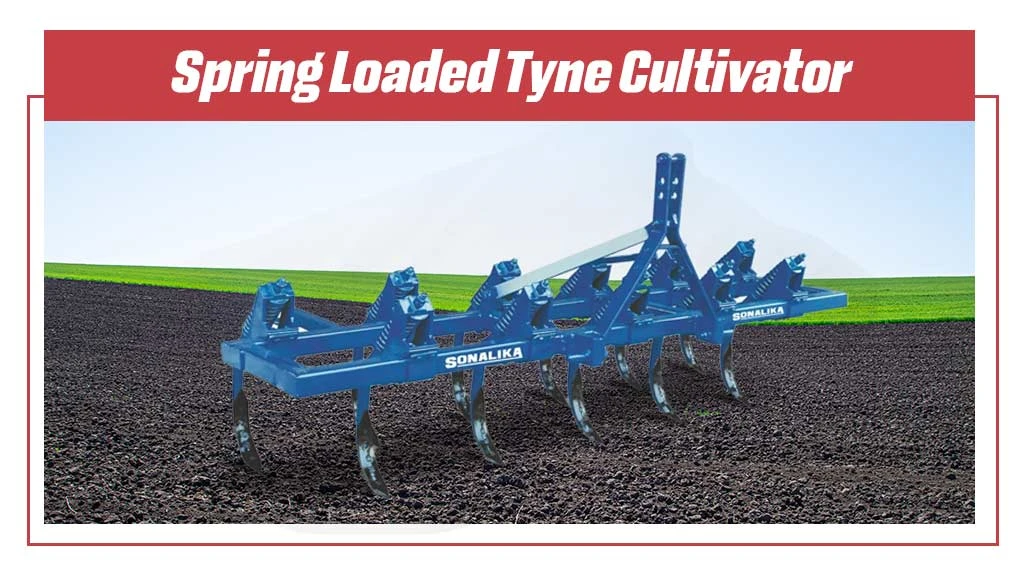
In these cultivators, the tynes are fitted to the main frame with the help of two heavy coil springs. The springs ensure that tynes spring back and do not get damaged upon encountering an obstacle. The tynes are made of high-quality carbon steel.
These types of cultivators are ideal for fields with stumps or stones. Depending on the farming requirements, they come with 7, 9, 11, 13 tynes or more.
In addition to the above, there is one more cultivator type known as Duck Foot cultivator. These have rigid tynes to which sweeps appearing like a duck foot are attached. They are ideal for shallow ploughing and are about 2250 mm long & 600 mm wide with 7 sweeps.
What are the Different Parts of a Cultivator?
- Frame
- Tynes or Blades
- Hitch
- Wheels
- Depth Control Lever
- Transport Wheels
- Shanks
- Gangs
- Shield
- Levelling Bar
What Adjustments are Required Before Attaching a Cultivator?
Before mounting the cultivator, ensure that all nuts & bolts are adequately tightened. Also determine soil and trash conditions of the field and make the preliminary adjustments.
Tyne levelling: Use the top link to level the tyne to eliminate uneven working and side draft.
Depth control: Use the control lever on the tractor to raise and lower the implement depth hydraulically.
How Do You Attach a Cultivator to a Tractor?
First, place the cultivator on a levelled, flat field.
Second, do not drag the cultivator to the tractor; instead, reverse the tractor to the cultivator.
Third, attach the left arm of the tractor to the cultivator, then the central arm and lower right arm. While attaching, do ensure that all arms are aligned to the respective holes and then insert the pin & lock it with a lynch pin.
Finally, lift the cultivator and adjust the control arm parallel to the ground. When you look from both rear and sideways, all shovels should be touching the ground uniformly.
What Safety Measures Shall We Take While Attaching a Cultivator?
- Always avoid working under a raised cultivator unless it is held in position or securely blocked.
- Use front weight to counterbalance the cultivator's weight, if required.
- Always slow down on turns or bumps and avoid excessive speeding during operation.
- Before you operate the field cultivator, check all pins, bolts, and connections to ensure they are securely in place. Replace any damaged or worn parts immediately.
- Operating rigid cultivator shanks may suddenly fling rocks and clods. So, always ensure that others are not standing near the cultivator.
- Always be sure the implement is in the fully raised position and you are using transport lock, if available.
Conclusion
A cultivator is a critical secondary tillage implement required to prepare seedbeds and remove weeds. Depending upon your farming requirement, you can choose a particular type of cultivator. Ensure that you are correctly attaching the cultivator to the tractor so that it performs efficiently, and always take safety precautions while operating a cultivator.
Today, many cultivators of top brands are available in the market. To know the top 10 cultivator brands, you can visit Tractorkarvan.
Frequently Asked Questions On Know Everything About Cultivator: Its Types, Uses and How to Attach It
1. What is a cultivator?
A cultivator is a secondary tillage implement that is equipped with laterally adjusted tynes or discs designed to operate between two crops.
2. What are the primary uses of cultivators?
The primary uses of a cultivator are tilling the land, turning over the soil, breaking the soil clods, preparing seedbeds, and uprooting weeds.
3. What are the types of cultivators?
There are two main types of cultivators: trailed and mounted. The mounted type is further classified into rigid and spring-loaded tyne cultivators. In addition to this, there is also a duck-foot cultivator.


Related Blogs
